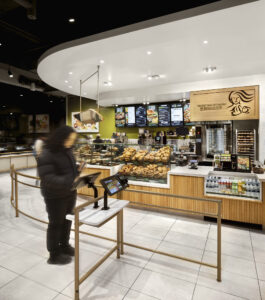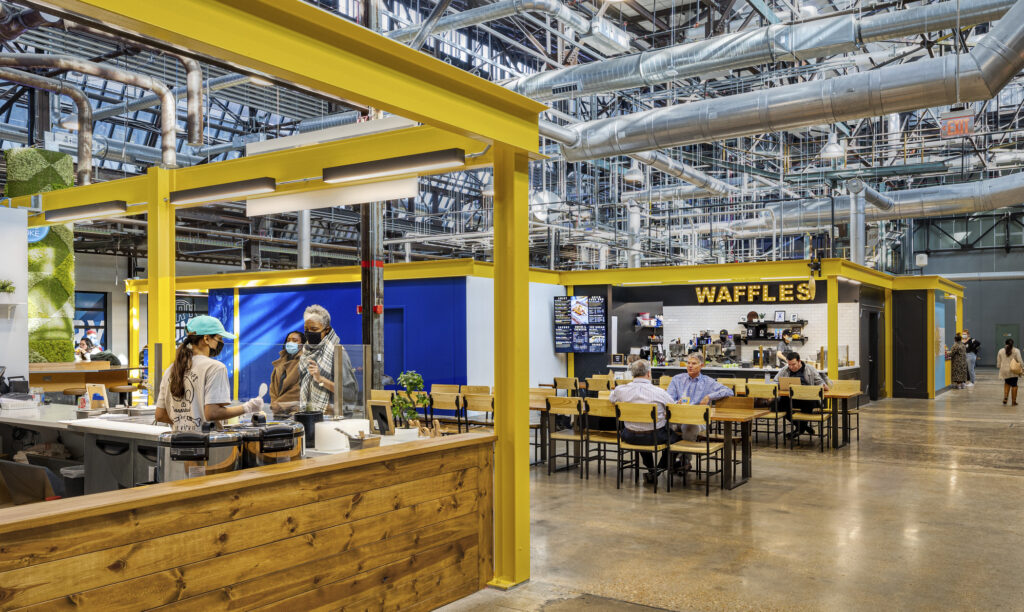Fast-casual dining has become a staple of modern life, from the cities to the suburbs across America. The global fast-casual restaurant market was valued at over $179 billion in 2024 and is projected to reach over $190 billion by the end of 2025, according to data from Straits Research. Whether working professionals, college students, or families, people enjoy the combination of quality, nutritious food and ingredients combined with unique dining experiences and convenient, technology-driven takeout options that these concepts offer.
Considered a step above traditional fast food and more efficient and affordable than fine dining, the fast-casual market has exploded in recent years. According to a recent report by market research leader Technavio, the U.S. fast-casual restaurant market is estimated to grow by $84.5 billion from 2025 to 2029.
With a nonstop sea of choices, fast-casual restaurant design must keep up with new technology and trends to cater to evolving consumer needs. Lawrence Group Retail Team has collaborated with some of the top fast-casual brands and concepts that consistently stay ahead of the curve, elevating the customer experience at every turn.
One of the most notable of these is Panera’s Urban Cafes. When it comes to food, many new concepts roll out first in New York City – the epicenter of dining and culture. Lawrence Group collaborated with this iconic brand to launch five unique concept locations in Manhattan following the pandemic. Restaurants were forced to pivot during the height of the Covid-19 pandemic, and it had lasting effects that continue to shape their design and operation today.

“It’s this idea of trying to figure out how you cater to the folks that still want that hands-free delivery system versus the folks that want to come in and sit down and enjoy the restaurant. We’re trying to accommodate and make them all seamlessly come together so it feels cohesive,” says Todd Bundren, Retail Principal for Lawrence Group.
With a brand like Panera that has over 3,000 locations across the country, it takes an occasional reinvention to stay relevant in the market while remaining on brand. The Urban Cafes were that reinvention. With no two spaces being exactly alike, there was no prototype to rely on. The cafes were specifically designed to meet the needs of busy New Yorkers with a heavy focus on rapid pickup and high traffic.
“Many of the customer interactions needed to be rethought completely, because you’re dealing with a very fast-paced urban environment,” Bundren says. “We played with a lot of different types of colors and palettes and types of furniture, and considered things like how you give someone the ability to plug in their phone and quickly charge it while they’re standing and eating a bagel, looking out a big picture window onto Broadway, and then be able to jump out in five minutes to make room for the next person.”
Working closely with the Panera design team on this unique, location-specific project strengthened the relationship and trust between Lawrence Group and their client and led to key learnings that are influencing the design of other new Panera cafes around the country.
“Out of that came the small box concept, which you’re going to start to see more and more, that is a more rapid pickup focus type of cafe that they can put in a high-traffic area,” Bundren says. “It can go into Chicago or downtown Omaha, or somewhere there is a little bit of vibrancy. There’s still some seating, but it’s really focused on the fast pace.”
On the other end of the fast-casual spectrum, Lawrence Group was on the ground floor of creating a one-of-a-kind, hyper-local dining experience in the heart of their home city of St. Louis – City Foundry STL. Lawrence Group worked closely with local, civic, and political leadership on this 15-acre adaptive reuse project to reimagine the former Federal-Mogul foundry site into a 21st-century mixed-use development that celebrates creative concepts in food, commerce, and entrepreneurship.
The first phase of this award-winning project was the creation of an industrial modern fast-casual food hall designed to be an incubator for up-and-coming local chefs and restaurant concepts, providing a built-in infrastructure for them to experiment and grow.
“Lawrence Group has always been dedicated to St Louis, so it fits in with our core mission of helping revitalize the city the best we can,” Bundren says. “It also provided this laboratory of the culinary arts in order to see what happens if you give people an opportunity.”
The huge, open hall is designed with a centrally-located bar and plenty of varied-height seating options. Surrounding the bar are individual, outward-facing pods or mini-restaurants, complete with customer counters and kitchens, each with their own branded signage, allowing visitors to circulate through the space and “shop” while still having an intimate moment with each restaurant. Bright yellow beams frame and separate the individual restaurant pods.
High ceilings with open ductwork, concrete floors and incorporated relics from the Foundry’s operations complete the unique feel and experience. Entertainment offerings and retail shops surround the food hall, making City Foundry a true destination that looks to the city’s future while honoring its past.
“The idea was to keep that spirit of the foundry alive, so you felt like you were inside of something you shouldn’t be in – like dining inside of a factory of some sort,” Bundren says. “We wanted to make it exciting, active, and also convenient, which is why we have an app that you can use to order from any restaurant and go pick it up.”

Lawrence Group also loves working with rising fast-casual brands like Teriyaki Madness, an eclectic fresh Asian grill with an aggressive expansion plan. With bright and colorful stores and an open kitchen that allows customers to see their food being cooked, Teriyaki Madness prides itself on fresh ingredients and healthier fast-casual fare. “The brand sticks to you,” says Bundren.
The in-house design and construction teams work closely with Lawrence Group’s retail team to help individual franchisees bring that brand to life in their chosen locations, integrating technology and creating a layout that best serves the customer experience.
“It gives you opportunities to just think about how people interact every day with the space. How can someone truly enjoy this restaurant? Once you get that nailed down, then you just build around it,” says Bundren.
“What I see in the fast casual space is always trying to catch the trend right – trying to see where your customer is and meet them there and then try to push them a little bit.”
